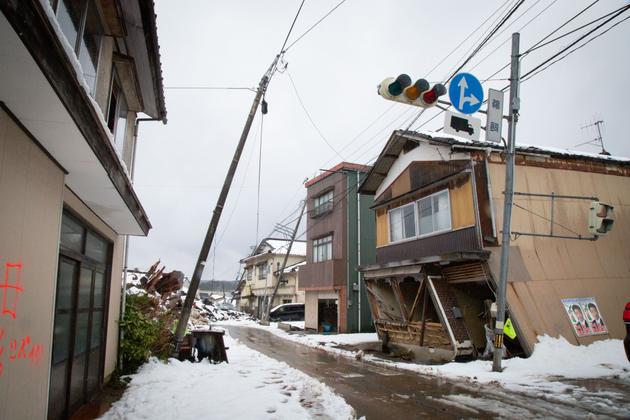


Japan earthquake: In the heart of the battered Noto peninsula, 'it's as if we've become an island'
NewsRescuers are still searching for around 50 people missing in the snow and icy wind, 10 days after the earthquake.
Ten days after the magnitude 7.6 earthquake hit the Noto peninsula (Ishikawa prefecture, west coast of Japan), rescue workers are continuing their efforts to find the last of the missing persons – 52 as of January 10 – amid the rubble of collapsed houses. Ignoring the criticisms leveled at a government deemed slow to react, firemen, police, soldiers and volunteers continue to navigate through a shapeless mass of rain-soaked, snow-covered rubble, swept by an icy wind, under the looming threat of aftershocks; there have been 1,219 since the main quake.
The provisional death toll stands at 206, including a 5-year-old child. The pain is all the more acute because the January 1 earthquake disrupted the Japanese people's most precious time. Shogatsu is the period at the beginning of the year when they take a break, gather with their families to enjoy osechi cuisine, specially prepared for the New Year, and pray for a good year at the temple. In Noto, where almost 40% of residents are over 65, this time meant reunions with children and grandchildren from all over the archipelago. These celebrations turned into a tragedy.
In an effort to appease the divinities at the start of the Year of the Dragon, the Kanazawa Noh Museum dedicated to theater, in the south of the peninsula, upheld the traditional performance of Okina on January 7, the oldest play and the one most closely resembling a religious rite. "This year, the performance takes on a particular significance. In Noto, people are lacking in everything. There's no communication, the roads are cut off. It's as if the peninsula has become an island," said Maiko Yamauchi, the museum's curator.
Destruction of the water network

It has left a palpable impression on this spit of land renowned for its seafood, sake and lacquer crafts. Access to Noto is via a limited number of cracked roads through mountain landscapes placed on red alert for landslides by the Japan Meteorological Agency (JMA). The 28,301 evacuees and survivors are experiencing the consequences of the destroyed water network – 35,000 households are without water – precarious hygiene conditions and aid trickling in slowly. The situation worsens moving northward toward the earthquake's epicenter, at the extreme tip of the peninsula.
Suzu is the closest town. Along with the village of Noto, it was the only locality affected by the tsunami that followed the earthquake. Entire neighborhoods there were devastated by the earthquake and the tidal wave. In Ukai, not a single house was spared. Not a pole was still standing. Cables lay on the ground. The snow hid the dangers. Search efforts continued cautiously, house by house, to find the 15 missing in a city that marked 91 dead, 145 injured and 90% of buildings damaged or destroyed. Police officers marked the walls in red spray paint to denote the day they passed through and the name of their unit.
You have 75% of this article left to read. The rest is for subscribers only.
